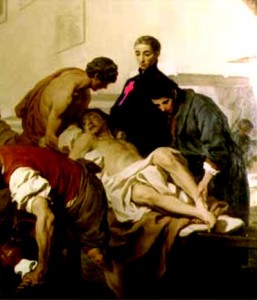 In May 1624 Palermo was invaded by the bubonic plague.* Probably this was the first encounter that the Order had had with it. The previous epidemics (in particular that of 1590-1 in Rome) were examples of epidemic typhus or pestilential fevers. The word ‘plague’ referred to an epidemic or some specific kind of epidemic.
In May 1624 Palermo was invaded by the bubonic plague.* Probably this was the first encounter that the Order had had with it. The previous epidemics (in particular that of 1590-1 in Rome) were examples of epidemic typhus or pestilential fevers. The word ‘plague’ referred to an epidemic or some specific kind of epidemic.
The plague was brought to Italy in 1630 by the French and imperial troops who had entered the peninsula because of the war of succession of the Dukedom of Mantua. The plague entered by two routes: with the French troops who entered Piedmont at Susa in order to besiege Casale Monferrato and with the Lansquenets of Ferdinand II who came to Italy to conquer Mantua. In a short time almost the whole of the peninsula was struck not only by war but also by the epidemic. The first city to suffer was Mantua which was subject to a siege in September 1629 by the Lansquenets whose ranks contained the plague which penetrated the city towards the end of December and spread widely, even though the physicians during the initial months denied its existence. In the middle of July 1630 Mantua, which was seen as ‘one of the most splendid capitals of the Renaissance’, was attacked and barbarously sacked for three days by the attacking troops. At the same time the plague continued its massacres. Mantua’s 50,000 inhabitants were reduced to 7,000 ‘yellow and emaciated figures’. Amongst the religious who provided help to the population and the plague-stricken, declared a local historian of the eighteenth century, Federico Amadei, there ‘stood out above all others the Fathers Ministers of the Sick (who in Mantua were called of St. Thomas) who hurried everywhere to give comfort to the poor dying people’. Even during the siege they commanded through their apostolate ‘the admiration of those savage rapacious mercenaries…who did not dare to use against them the burnings, the stripping of flesh, the flayings, the beatings and the amputations with which they tormented in public, in homes and cloisters, those most unhappy citizens…And after being worn down for those afflicted people they went to heaven after dying, as victims of charity, expiatory hosts, burnt offerings to make divine mercy propitious’.
During the epidemic of 1630 the Order provided very important proof of its capacity for dedication. Nine communities were put to the test: at Milan, Mantua, Bologna, Ferrara, Florence, Borgonovo, Mondovì, Occimiano and Rome. In addition there was the help provided to localities where our religious did not have houses, such as Modena, Imola and Lucca. The religious who were involved in providing care to people infected with the plague or with work involving cleaning were almost 120 in number, of whom 56 died because of the plague, almost all of whom ‘serving the plague-stricken’. Amongst the victims were religious of great capacity who held positions of responsibility in the Order, and to such an extent that their deaths created notable empty spaces. The General Consulta was alarmed about this and given that its mandate was about to expire, and it was not able to hold the general chapter in May 1631, it asked for, and obtained, a prorogation from the Holy See for three years so that it could reorganise its ranks and replace those who had fallen.
* It is striking that in the Positio San Camillo we find a list of the religious who died of the plague updated to the date of the publication of the proceedings (1681) It was reproduced in the Memorie storiche of Domenico Regi which had appeared five years previously. In all they numbered 168. The record was the house of Naples with 39 deaths and 1 death in Gaeta, with 33 victims in Genoa in the same year. But honours also went to Palermo in 1624 with 10, Mantua in 1630 with 10, Milan in 1630 with 20, and Bologna in 1630 with 7. One wonders why they were cited by name in a canonical process that was extraneous to them as individuals. The answer can be quickly given: they testified to the holiness of Camillus in having transmitted to his sons a spirituality that was able risk death during a pestilence. Before being debilitated by the advance of medicine and improvements in hygienic conditions, epidemics of the plague continued to be a recurrent danger and a nightmare. The so-called black death (which was pulmonary and septicaemic) even came close to a 100% death rate; bubonic plague reached and went beyond 50%. The Camillian Order honours these religious as martyrs to charity and commemorates them every 25 May.














Camillians on Facebook
Camillians on Twitter
Camillians on Instagram